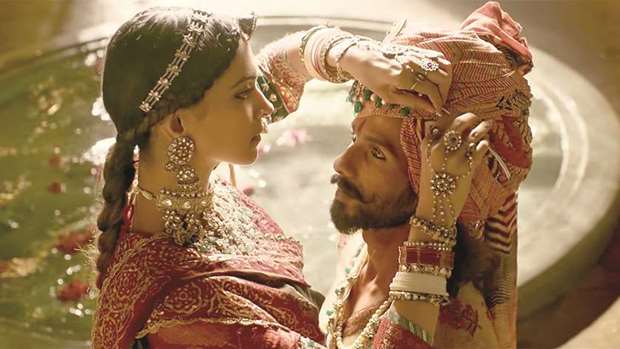Art and culture in India are under threat. And so often this comes from fringe political groups, whose narrow-minded, outdated and radical thinking have begun to play havoc in a nation known for its pluralistic and liberal values. If Deepa Mehta and her two actresses were chased out of Varanasi by extremist groups which believed that the director was making a film, Water, that was anti-Indian, the same kind of men had Karan Johar begging to get his Ae Dil Hai Mushkil released. It had a Pakistani actor, Fawad Khan, and this was a no no at that point in time.
And now, the recent weeks saw the Karni Sena, a quasi-political organisation in Rajasthan, baying for the blood of director Sanjay Leela Bhansali and actress Deepika Padukone. She plays Padmavathi in the movie, Padmaavat, a legendary 13h century Hindu Rajput queen who defies the Muslim Sultan of Delhi, Alauddin Khilji, out to plunder her tiny kingdom of Mewar.
When her husband, the king, dies, Padmavathi fearing rape and murder at the hands of the invading army, leads the entire womenfolk to commit Jauhar or suicide by jumping into fire.
Honestly, I could not, for the world of me, fathom why the Karni Sena had been opposing Padmaavat, re-titled from Padmavathi to appease hostile sentiments. Padukone, whose nose was on the block (and Bhansali’s head as well), is shown as an honourable, dignified queen, who not only saves her king, Ratan Singh (Shahid Kapoor), the first time he is captured by Khilji and imprisoned in Delhi, but also frustrates the sultan’s obsessive desire to possess her, smitten as he was by her ethereal beauty. Which he has not seen, but only heard about!
And. Padmaavat is shamelessly anti-Khilji, which many in India saw as anti-Muslim. Ranveer Singh as Khilji is all dark. He is shown as a virtual beast, pouncing on food and women. He does not let go them even on the day of his marriage to Mehrunisa/actress Aditi Rao Hydari. (The real Khilji was not just this; he was celebrated for pathbreaking administrative reforms that the later rulers followed.) So, what was Sena’s problem with Bhansali’s creation?
Now for the actual cake. There is absolutely no record, whatsoever, that a queen named Padmavathi ever existed in history. She is the figment of imagination — the imagination of a Sufi poet, Malik Muhammad Jayasi, who in 1540 wrote the epic Padmaavat, in which a brave and beautiful Rajput queen chose to immolate herself in a ceremonial fire rather than be captured by Alauddin Khilji.
Bhansali’s film is based on this, and so it was not even history that the Sena was talking about, but a mere folklore.
Interestingly, while the Sena was crying hoarse about how the movie had tarnished Rajput honour, a 25-year-old teacher in Rajasthan told Huffington Post that women should never think of Padmavathi as a role model. But of course. How can any woman in this day and age think of immolating herself! How could she!
As for the Bhansali’s film, while it looks pretty, picture perfect, an eyeful — with its lavish sets and attractive women seen in seductive colours — Padmaavat offers nothing beyond these. It is a soulless dramatisation of an insipid story of a mad Sultan, who infatuated with the divinely good looks of a queen, is crazy about possessing her. And you have a Rajput king, who blunders and blunders all in the name of honour only to be killed on the battlefield by Khilji›s loyal slave. There are no great performances either, and I saw Ranvir Singh’s acting as uncomfortably exaggerated. He was merely pushing home a point of view that Bhansali’s script chose to propagate. Kapoor presented a sad spectacle, hardly the kind of image one would have associated a mighty warrior king with. Padukone was just too artificial to create any lasting impression.
* * *
Nimir
Tamil moviemakers have hardly ever been good with remakes. The Suriya-starrer, Thaana Serndha Koottam, inspired by Neeraj Pandey’s riveting thriller in Hindi, Special 26, was a disaster. A while ago, Jeetu Joseph’s 2013 Drishyam in Malayalam with Mohanlal remade in Tamil and titled Papanasam, did not quite live up to the original. This despite the fact that the Tamil version was also helmed by Joseph and had a great actor like Kamal Haasan reprising Mohanlal›s role. I think the reason for this disappointment was Kamal’s idea (or insistence) that Jospeh should infuse the lead character with a liberal dose of emotion. This is where the Tamil work slipped, because Mohanlal’s Georgekutty — a smalltime television cable operator having dropped out of school when he was in class four — had an animal-like cunning, sans any emotional pull and was singularly bent on saving his small family from the clutches of cops. He succeeded with marvellous ease. Kamal got sucked into tears and lost the battle.
It is not very different with Priyadarshan’s Nimir, starring Udhayanidhi Stalin. This Tamil movie, culled out of the Malayalam gripper, Maheshinte Prathikaaram, a debut outing from Dileesh Pothan, is not half as exciting as the original was. Though the storylines are more or less similar, Fahadh Faasil gave an extraordinary performance in the Malayalam work as a smalltime photographer with a studio in a small town catering essentially to a clientele which was more than happy with passport photographs. Till of course, a young woman troops into his studio looking for a picture of herself that she can have it published on the cover of a magazine.
But this is only a sub-plot, because the main narrative focuses on the lensman’s anger over being beaten up by a ruffian. Humiliated, the bruised and battered guy vows revenge, and promises himself and his well-wishers that he will go barefoot till he lays his hands on the bully. But the toughie, Vellaiyappan — played engagingly in Nimir by Samuthirkani — has a sister, Malar (Namitha Promod), and she flips for Stalin’s Selvam.
If Nimir gets into distractive songs and dances, Stalin certainly does not have the kind of screen presence that Faasil had. And the Tamil actor also looks uncomfortably wooden to essay a man whose pride has taken a severe beating (with his veshti/dhoti ripped off by Vellaiyappan in a crowded bazar), and who has also gone through the trauma of losing his childhood sweetheart, Valli (Parvathy Nair), to a rich policeman. And, why cast a great actor (and a great director) like J Mahendran in an utterly insignificant part, that of Selvam’s father. For, most of the time the older man appears he confines himself to monosyllabic utterances!
However, one must laud Nimir — as also many other Tamil films — for its guts to set its story in a small town. Tamil cinema is perhaps the only one in India that still weaves its plots around the countryside, its actors still bold enough to be seen in a veshti, its actresses in a half-sari. And, Nimir uses the lushness of Tenkasi and surrounding areas to visually captivate us. It is really a treat to see the greenery and the mountains beyond in a story that could have unfolded anywhere else. Priyadarshan is well known for the way he gets the magic of the landscape into his frames, and this undoubtedly enriches his cinema.
* Gautaman Bhaskaran has been
writing on Indian and world cinema close to four decades, and may be e-mailed at [email protected]

NOT WORTH A SHOUT: Padmaavat lead Deepika Padukone with Shahid Kapoor during a scene.


